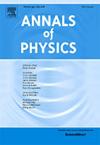Optically controlled topological phases in the deformed α-T3 lattice
IF 3
3区 物理与天体物理
Q2 PHYSICS, MULTIDISCIPLINARY
引用次数: 0
Abstract
Haldane’s tight-binding model, which describes a Chern insulator in a two-dimensional hexagonal lattice, exhibits quantum Hall conductivity without an external magnetic field. Here, we explore an lattice subjected to circularly polarized off-resonance light. This lattice, composed of two sublattices (A and B) and a central site (C) per unit cell, undergoes deformation by varying the hopping parameter while keeping . Analytical expressions for quasi-energies in the first Brillouin zone reveal significant effects of symmetry breaking. Circularly polarized light lifts the degeneracy of Dirac points, shifting the cones from M. This deformation evolves with , breaking symmetry at , as observed in Berry curvature diagrams. In the standard case (), particle-hole and inversion symmetries are preserved for and . The system transitions from a semi-metal to a Chern insulator, with band-specific Chern numbers: , , and for shifting to , , and when For , the system enters a trivial insulating phase. These transitions, confirmed via Wannier charge centres, are accompanied by a diminishing Hall conductivity. Our findings highlight tunable topological phases in lattices, driven by light and structural deformation, with promising implications for quantum materials.
形变α-T3晶格中的光学控制拓扑相
霍尔丹的紧密结合模型描述了二维六边形晶格中的陈氏绝缘体,在没有外部磁场的情况下表现出量子霍尔电导率。在这里,我们研究了圆偏振非共振光作用下的α−T3晶格。该晶格由两个子晶格(A和B)和一个中心点(C)组成,在保持γ2=γ3=γ的情况下,通过改变跳变参数γ1进行变形。第一布里渊区准能量的解析表达式揭示了对称破缺的显著影响。圆偏光提升了狄拉克点的简并性,使锥从m移开。这种变形随着γ - 1的变化而变化,在γ - 1=2γ处打破了对称性,正如在Berry曲率图中观察到的那样。在标准情况下(γ1=γ),当α=0和α=1时,粒子-空穴对称性和反演对称性保持不变。系统从半金属过渡到陈氏绝缘体,具有特定频段的陈氏数:对于α<;1/2, C2=1, C1=0和C0=−1,当α大于或等于1/2时,转移到C2=2, C1=0和C0=−2。对于γ1>;2γ,系统进入一个平凡的绝缘阶段。这些转变,通过万尼尔电荷中心证实,伴随着霍尔电导率的减小。我们的研究结果突出了α−T3晶格中可调谐的拓扑相,由光和结构变形驱动,对量子材料具有很好的意义。
本文章由计算机程序翻译,如有差异,请以英文原文为准。
求助全文
约1分钟内获得全文
求助全文
来源期刊

Annals of Physics
物理-物理:综合
CiteScore
5.30
自引率
3.30%
发文量
211
审稿时长
47 days
期刊介绍:
Annals of Physics presents original work in all areas of basic theoretic physics research. Ideas are developed and fully explored, and thorough treatment is given to first principles and ultimate applications. Annals of Physics emphasizes clarity and intelligibility in the articles it publishes, thus making them as accessible as possible. Readers familiar with recent developments in the field are provided with sufficient detail and background to follow the arguments and understand their significance.
The Editors of the journal cover all fields of theoretical physics. Articles published in the journal are typically longer than 20 pages.
 求助内容:
求助内容: 应助结果提醒方式:
应助结果提醒方式:


